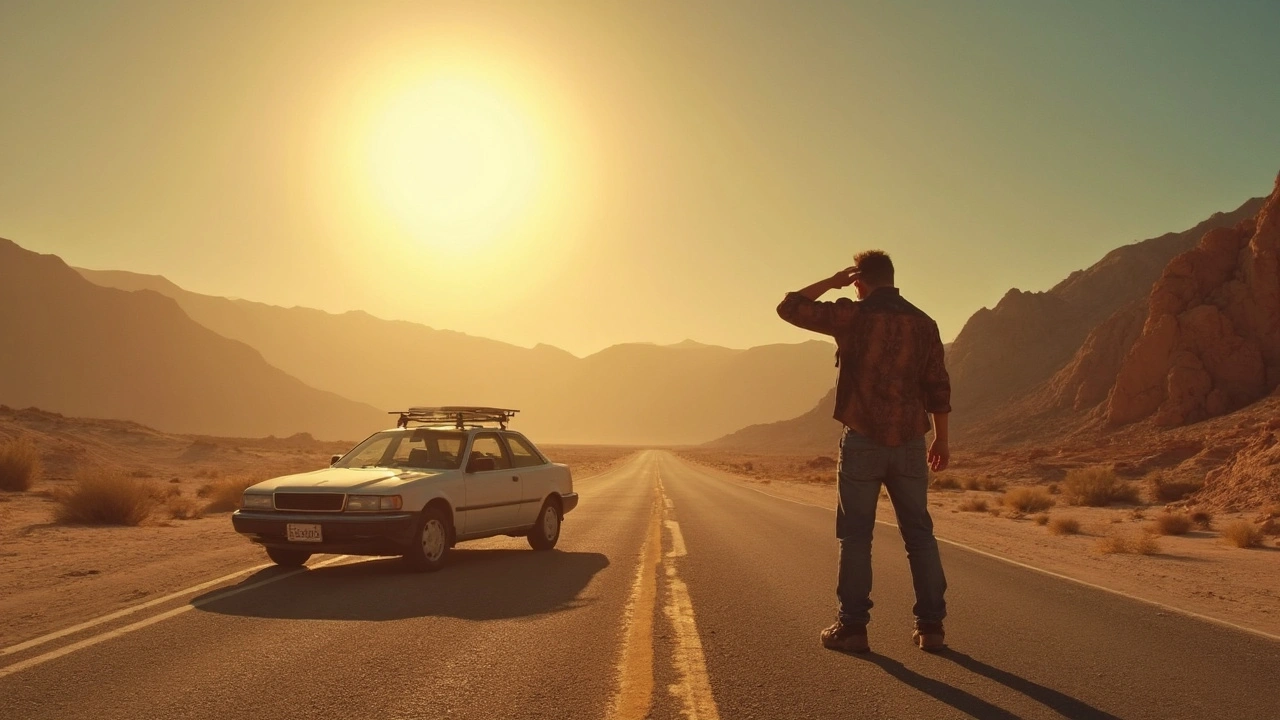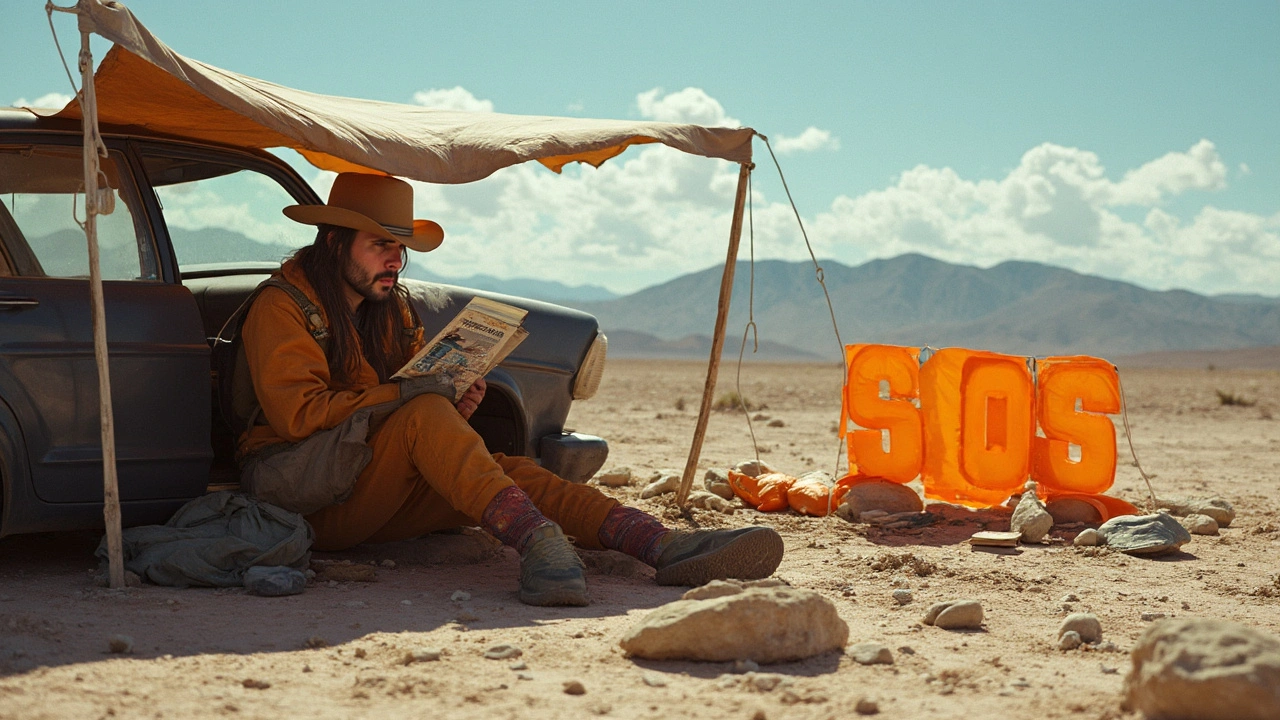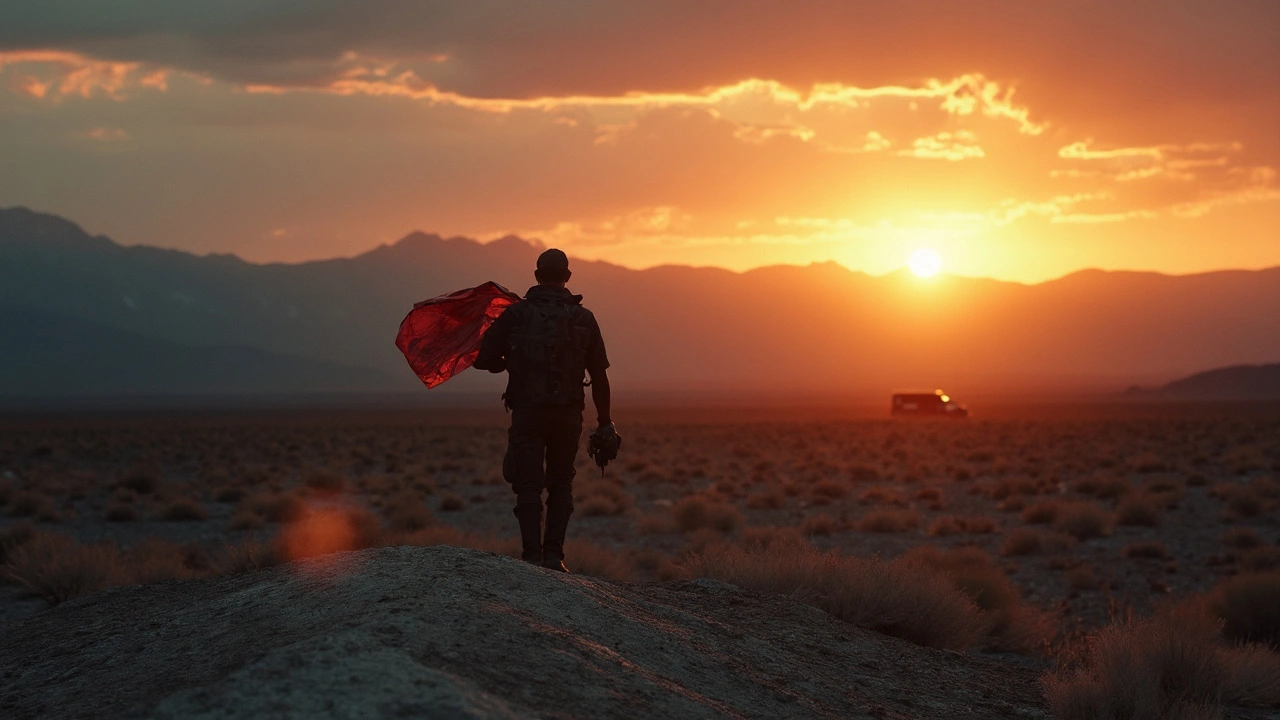What To Do If Your Car Breaks Down In Death Valley: Survival Guide And Real Advice

Imagine yourself behind the wheel, windshield glittering with heat. The land looks like another planet: yellow rock, endless salt, not a tree for miles. Death Valley holds the record for the highest air temperature on Earth—56.7°C (134°F) in 1913. So if your car breaks down here, it’s not just a hassle. It’s a fight for survival in the world’s most punishing terrain. Back in 2022, a family ran dry down West Side Road for just three hours and barely made it out. Stories like these make you realize why basic breakdowns go very wrong here.
This stretch of desert averages just over two inches of rain a year. There’s spotty cell service at best, and even the AAA can take hours—if they can even reach you. Distances are huge: there’s almost 125 miles of nothing between Furnace Creek and Baker. And for every tourist who rolls through with a rental and a selfie stick, there are a handful who run out of luck. Death Valley Search and Rescue never stops patrolling, because cars drop dead here every season, from radiator blowouts to plain old flat tires. If you don’t prep, nature won’t cut you a break.
What Actually Happens When Your Car Breaks Down in Death Valley?
The second your car sputters and stops, you go from road-tripper to survivor. The heat is brutally real; standing in the sun, you can feel sweat evaporate faster than you can produce it. Most breakdowns aren’t dramatic: blown radiator hoses, dead batteries, a tire shredded by sharp volcanic rock. Rental cars love to overheat, since most folks drive too fast or run the AC constantly. If the smart dashboard goes dark, it’s you against the landscape.
Try your phone. Good luck—dead spots sprawl across Death Valley like landmines. Some stretches—Badwater Basin, Artists Drive, Dante’s View—are notorious for zero bars. Even if you connect, help may not reach you for hours. The heat is no joke; inside a closed car, temps can soar to 180°F, like a slow-cooker for humans. If you stay put with windows sealed, you risk heatstroke. Open them, you lose what little shade you have.
Dehydration sets in fast. Even sitting still, you’ll lose about a liter of water every hour through sweat and breathing. And if you thought hiking out for help was smart, think again. Death Valley has tricked folks with how far things look. That shimmering oasis? Probably twelve brutal, foot-blistering miles away. Venturing out is legendary for deadly outcomes; a group of tourists in 2009 barely survived when they set off for a ranger station that seemed “close.” They were rescued after 24 hours, but only because they’d planned ahead with extra water and a GPS messenger.
So what actually happens? Most people do survive, especially if they stay with their vehicle, shade up, ration their water, and don’t panic. But every summer, Death Valley’s extremes claim lives. That’s the hard truth: your outcome depends on your choices in the first hour.

How to Stay Alive If You’re Stranded in Death Valley
First thing—don’t leave your car. Your vehicle is visible, it provides some shade, and if rescuers are looking, it’s a lot easier to spot than a lone figure wandering under the sun. Crack the windows, let air flow, but stay out of direct sunlight as much as you can. A simple silver emergency blanket tossed across the windshield can lower the temperature a few degrees. That difference matters more than you’d think.
Water is life out here. The park service suggests one gallon per person, per day. If you break down with less, rationing gets tricky. Sip slowly, don’t chug. Salty snacks or food just make you thirstier—skip them unless you absolutely need energy. When I take Dashiell camping out there, we stash four gallons just for a day trip, plus electrolyte powder for good measure. Skip the beer, tea, or coffee; they steal water from your system.
If you have a reflective vest or bright shirt, hang it from your side mirror or antenna to flag down passing vehicles. At night, switch on your hazard lights if you’ve got battery left. And here’s something almost no one does but always should: jot down your location. Mile marker, GPS if you have it, a landmark you can see. That will help rescuers help you. Never abandon a passenger unless someone’s in medical crisis and you know exactly where you’re going—it’s safer to stay together, hunker down, and wait.
- If you have a GPS messenger (like a Garmin InReach or SPOT tracker), use it to send a help signal. These gadgets work way beyond cell coverage, and they literally save lives every season.
- If you’ve got flares or an emergency whistle, use them when you see or hear people or planes.
- If your car’s battery is good, use power sparingly. Play no music, turn off lights unless signaling, don’t charge gadgets unless you absolutely need to.
- Stretch out, rest, and limit talking. Physical activity speeds up dehydration.
- In the rare case there’s rain, collect all the water you can safely. But don’t count on it—eight out of ten times, Death Valley stays bone dry for months.
Heatstroke signs come fast: dizziness, pounding headache, nausea, confusion. Get victims out of the sun, use water to wet their skin, and fan them if you can. Check on kids and pets—they overheat twice as fast as adults. It sounds basic, but calling for help (if you can), waiting by your car, and keeping cool saves far more lives than heroic hiking.

How to Prepare Before Heading Into Death Valley (So You Don’t Get Stuck)
The folks who handle breakdowns best are the ones who planned like a doomsday prepper. The rest? They learn the hard way. Prepping for Death Valley starts with your ride. A healthy radiator, new hoses, and tires rated for heat and rough roads are non-negotiable. Since gas stations are scattered and never cheap, fill up every time you see one—even if your tank’s half full.
Load more water than you think you need. Triple it for summer visits. If you’re traveling with kids like Dashiell and me, double-check snacks, hats, sunscreen, and light-colored clothes. Toss in a solar charger, a printed map (yes, really—phones die fast in the heat), and a couple of N95 masks for dust storms. Don’t forget duct tape and a spare tire—not one of those “donut” spares, a real one. I can’t count the number of people I’ve seen limping out on wheels ruined by rocks or potholes.
Plan your route and share it with someone who isn’t coming. The National Park Service suggests always telling a friend which entrance you’ll use, when you expect to arrive and leave, and what kind of car you’re driving. Twenty minutes spent on this can mean the difference between a pleasant rescue and an all-out search party.
Pay attention to posted warnings. Death Valley’s roads might look inviting, but cheating the boundaries leads to getting stuck in sand or impassable canyons. Stay on paved or well-maintained roads unless you have a true off-road vehicle. Stick to the main sights if you’re not absolutely sure what you’re doing. It may hurt your adventurer pride, but it could save your skin.
And yeah, park fees might feel annoying, but a portion funds the rangers and rescue teams who will come when your trip goes south. Knowing what you’re up against—intense heat, deceptive distances, and no automatic help—makes it clear: this land rewards the prepared and punishes winging it. Bring lots of water, a solid plan, and a heavy dose of respect. If you do break down, you’ll be glad you did. Death Valley is stunning, but it has no patience for the cocky or careless—or anyone who forgot their spare water jug in the trunk.
Getting stranded in Death Valley sounds like a nightmare you only hear about in movies, but it’s brutally real for some poor souls. Seriously, this place is nature’s oven, and without a working AC or water, you’re basically toast. The first thing you've gotta do is stay put unless you’re certain you know exactly where to go—wandering around could mean you get lost or worse.
Also, keep that engine off to save fuel and battery if you’ve got no power. Use your emergency kit—signal mirrors, flares, whatever you have. Air rescue could take a while, but it’s often your best shot out. And don’t forget, let folks know your route and expected arrival time before you head into the desert.
One more tip: shade is everything. If you can’t repair your ride quickly, make a shelter with any materials you have to keep yourself from frying under the sun. Stay smart, stay hydrated, and keep hope alive, folks.
Omg, yes, totally! Death Valley is like this relentless beast, right? But staying chill and prepared is everything. 🌞💪 Always pack extra water and snacks because dehydration creeps up on you. I’ve actually read that some folks underestimate just how brutal that heat gets after noon—like, it can suck the life right outta you. Better to carry a hat and cover up.
And signal devices? Golden! I carry a little mirror and loud whistle which are lifesavers. It’s all about improvising and thinking ahead. Also, don’t forget to conserve your phone battery for emergencies—bring a power bank if you can. Staying optimistic helps survive the wait, trust me. You got this! 😎✌️
Hey, I’m actually curious about what kind of maintenance should folks do before hitting up places like Death Valley to avoid breakdowns in the first place? I mean, beyond the obvious oil and fuel check, are there specific tips you know that would help? Like certain tires or cooling systems maybe?
Also, does anyone know the best way to communicate if you lose signal? Some advice on walkie-talkies or satellite devices would be cool. I know it’s a challenge but better to overprepare than regret later!
Ah, but therein lies the question — what truly defines 'survival' in this parched expanse, stripped of interference and yet abundant in the silent ravages of heat? One must ponder: is it merely a mechanical failure that traps us, or the inherent chaos of the macroscopic eco-sphere? The ‘broken car’ is but a metaphor for the fragile constructs by which humans attempt dominion over the wild.
In truth, one’s survival hinges on understanding the susurrations of the desert winds, the entropy of heat dissipation, and the semiotics of distress signals – all lost to the uninitiated masses. Preparation transcends simple kits and manuals; it’s a rite of passage into the pantheon of those who read between the mirages.
This post is super helpful. I love how it emphasizes being prepared rather than scared. Sometimes it just takes a little calm and some common sense to get through tough spots like this.
Honestly, one of the most important things is knowing how much water to carry and how to ration it. People don’t realize how quickly dehydration sets in under those conditions. And having some way to signal for help without wandering far from your car is key, too.
Also, it’s great to remember that help can come but sometimes it takes time, so staying mentally strong is really a part of surviving. Thanks for sharing these tips, really needed that refresh.
Okay, I might be the only one here who thinks a lot of this survival advice is overhyped. I mean, yes, Death Valley is hellish, but a lot of what people panic about comes from movies and media feeding our fear. Sometimes the best way to survive is to accept your situation philosophically rather than scrambling blindly.
Also, there's this whole aura of doom that surrounds deserts, but humans have lived in harsh environments for millennia. Maybe our instinctual fear is just a form of control from modern safety-obsessed culture pushing us into anxiety rather than clear thinking.
Just my two cents, but staying calm and controlling the narrative in your own mind might be the biggest life-saver.
While I appreciate the concern, it’s imperative to be clear about the facts regarding survival in Death Valley. Carrying ample water, a well-maintained vehicle, and a charged communication device are not optional, they are necessities. Failure to prepare is, frankly, negligent.
Furthermore, panicking or unnecessary wandering only amplifies the risk. Stay by your vehicle, signal for help properly, and use resources judiciously. The rules here are simple, and adherence to them can save lives.
Let's avoid dramatizing but rather focus on educating people effectively with precise information.
Look, I get it, official guides are all about calm and orderly survival, but you gotta wonder if the whole 'help coming' thing is as rosy as they make it seem. What if you’re caught in a part of Death Valley where signal is a myth, emergency systems are corrupted, or they're purposely delayed for who knows what ulterior motive?
This isn’t just about a car breaking down; it's about being trapped in a geopolitical void, a no-man's land where normal rules don’t hold. The real survival trick might be figuring out who’s truly 'helping' and why. Food for thought.
Anyway, I still try to prep as best I can, but I keep my eyes peeled for the bigger picture.
Interesting points brought up here all around. From a practical standpoint, I want to highlight a few things that might get overlooked in all this chatter. Firstly, knowing your vehicle’s exact limits before entering such an environment is undeniably vital. Solar-powered chargers or satellite messengers could be lifesavers in zero-signal areas.
Also, pre-trip planning should include sharing your detailed itinerary with someone reliable and close. It's often these small, overlooked steps that make the difference between a story of survival and tragedy.
And yes, staying composed, hydrating properly, and conserving energy remain key. Hope everyone stays safe out there!
🙏Adding onto that last comment, didn’t wanna come off too preachy earlier, but you’re so right about letting someone know your plan. I’ve read that even local rangers suggest this as their first piece of advice. Sometimes the best rescuers aren’t the random onlookers but the people you’ve told about your route.
And to everyone stressing about philosophical angles or conspiracies—hey, sometimes simple practical steps make the difference, and honestly, that’s what counts when you’re out there baking under that sun.
Stay safe out there folks!✌️